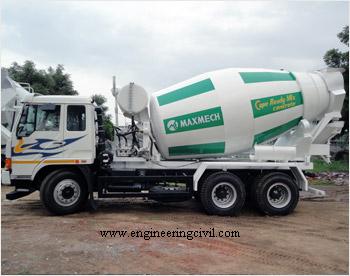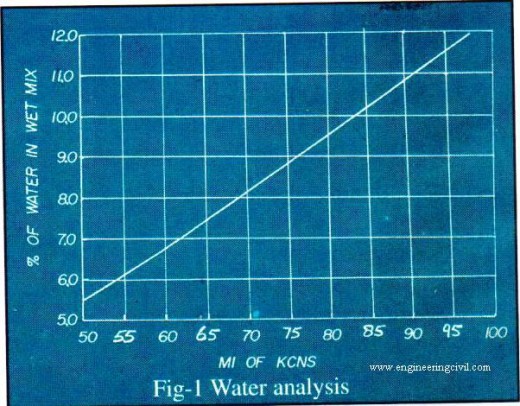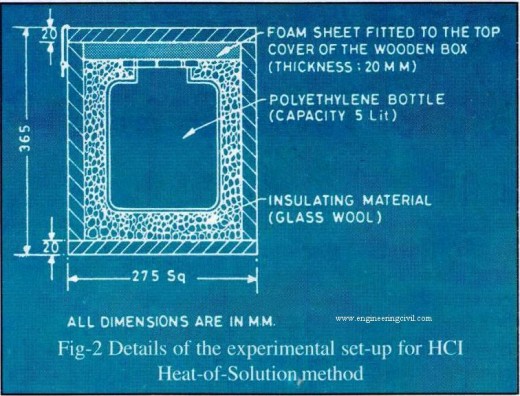By
KAUSHAL KISHORE
Materials Engineer, Roorkee
The time lag (usually 3 to 28 days) between concrete placement and the evaluation of cube strength is a primary deficiency of the current quality control method used in concrete construction. The development of accelerated curing techniques have reduced the lag time to 24 to 48 hours. But even the 24 hours time is sufficient to allow the concrete to set and harden in the form prior to the testing of the accelerated cubes. This paper describes the method for determination of water-cement ratio of the mix discharged from the mixer and conjunction with air-content tests can predict 28-days strength of concrete in 15 minutes, so that any mix found sub-standard should not be allowed for placement.
1) Water Content Test (Kelly and Vail’s method)
The method for the determination of water content is based on the principle that the free water is available to act as a diluents when an aqueous solution of sodium chloride of known strength is added to a sample of fresh concrete.
- Weigh out two separate one Kg samples of concrete and place each sample in a wide-mouth bottle. Add 500-ml to 0.5 N sodium chloride solution to one bottle (sample) and 500-ml of distilled water to the other bottle (blank).
- Seal the bottles and place then in an end-over mixer; operate 3 minutes.
- Remove the bottles from the mixer and allow the contents to settle for 3 minutes.
- Pipette 50-ml samples of clear supernatant liquid from the sample and blank bottles and add to separate Erlenmeyer flasks. To each flask (sample and blank) add 10-ml of 50 percent nitric acid, 2-ml of nitrobenzene, and 5-ml of ferric alum. Shake well.
- Determine the chloride content of the sample and blank flasks by adding excess silver nitrate (50-ml of 0.5 N AGNO3 for sample and 10-ml of 0.5 N AGNO3 for blank) and back-titrating with 0.05 N potassium thiocyanate (Volhard back-titration).
- Record the quantity of potassium thiocyanate required to reach the white to reddish-brown end point in both the sample and the blank. Use figure 1 to determine the water content of the mix. Quantity of KCNS (ml) required for sample titration plus the back-titration of blank (100 minus the KCNS required for blank titration) equals the abscissa of figure 1.
2) Cement Content Test
This method has been developed in Japan. In this method the cement content is obtained by virtue of the temperature difference which arises on account of the heat evolved by the reaction between cement and hydrochloric acid added to the diluted mortar solution. A known weight of mortar sample is first obtained from the sample of fresh concrete by sieving. The mortar sample is then diluted by adding a fixed quantity of water. With addition of HCL, the dilute solution of mortar undergoes an abrupt exothermic reaction, which decomposes the cement contained in the sample. The aggregate (except calcareous) do not react which HCL. The heat of reaction reaches a steady temperature very quickly and there exists a relationship between the temperature difference and the cement content of the sample of concrete.
National Council for Cement and Building Materials conducted experiments on concrete samples instead of sieved mortar sample. The experimental set-up (Fig. 2) consisted of a wooden box in which a 5-litre capacity polyethylene bottle surrounded by glass wool was placed. About one Kg concrete sample was first diluted with 800 cc water to which 500 gm of concentrated HCL was added. The mixture was stirred with a rod and the temperature of the mixture was measured with a thermometer. The experimental investigation resulted in the following regression equation:
Y = 12.28 + 3X
Where : Y = cement content (in gm) of the sample of concrete, and
X = temperature difference of oC
The above method is applicable only for concrete made with OPC, if the pozzolana content in PPC is known, then this method can be used after making due corrections for the amount of pozzolana in the cement content so determined.
Air content of the sample can be determined by conventional methods. Thus knowing the water-cement ratio and air-content concrete 28-days strength can be predicted. For a direct approach in predicting the concrete strength, it is desirable that water-cement ratio v/s 28-days concrete cube strength curves be drawn from the actual site materials.
References
1. Evaluation of Quality of in-place Fresh Concrete-Cement Research Institute of India.
2. Kanda M.A. measuring method for water-cement ratio in fresh concrete. Transaction of Japan Society of Civil Engineers, 3,2. November, 1972.
3. A. Howdyshell, Operation Guide – Water and Cement content of fresh Concrete, Technical Report M-177 (CERL, Feb, 1976).

We at engineeringcivil.com are thankful to Sir Kaushal Kishore for submitting this paper to us. We are hopeful that this paper will help students who wish to know more about concrete quality control.
If you have a query, you can ask a question here.





I just discovered this site and am so proud of belonging to the quality of professionals whose ideas are expounded in this .
It’s indeed very useful,I’ll search some of my materials for submission so that others can benefit as well.
Great Job guys!!!
What type of new thing can i do in this project please help me for final project.
please!!